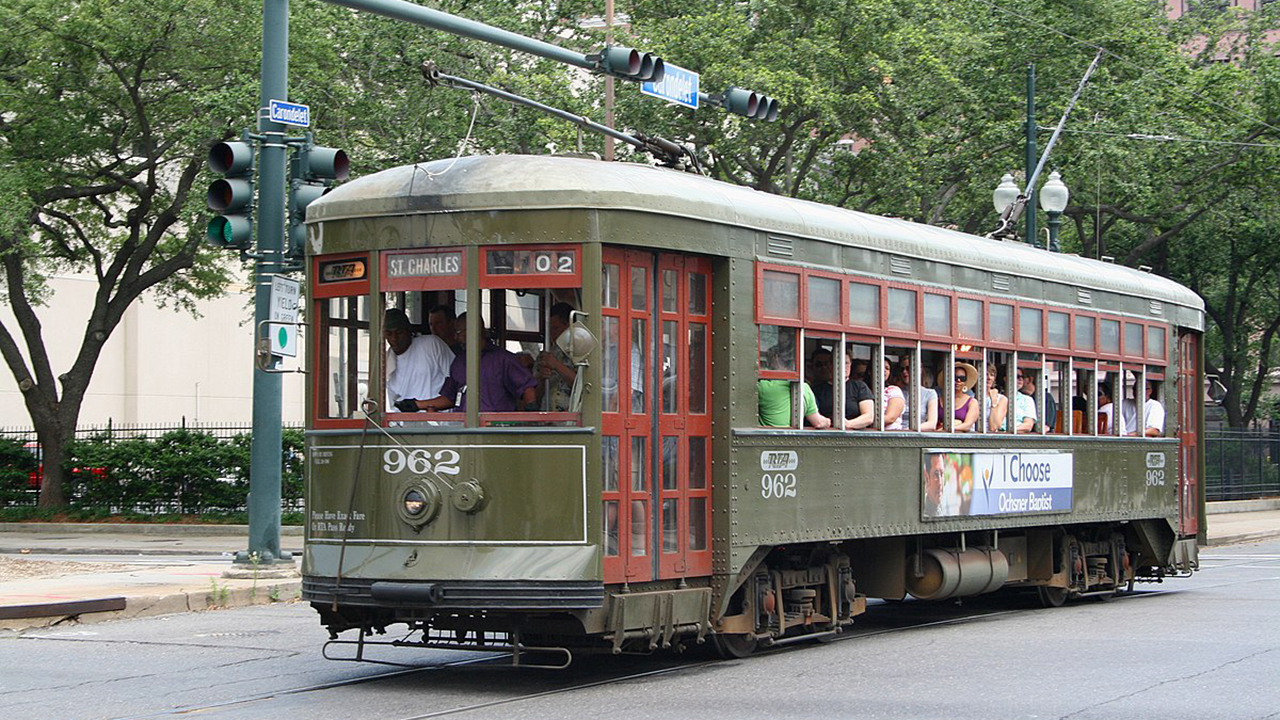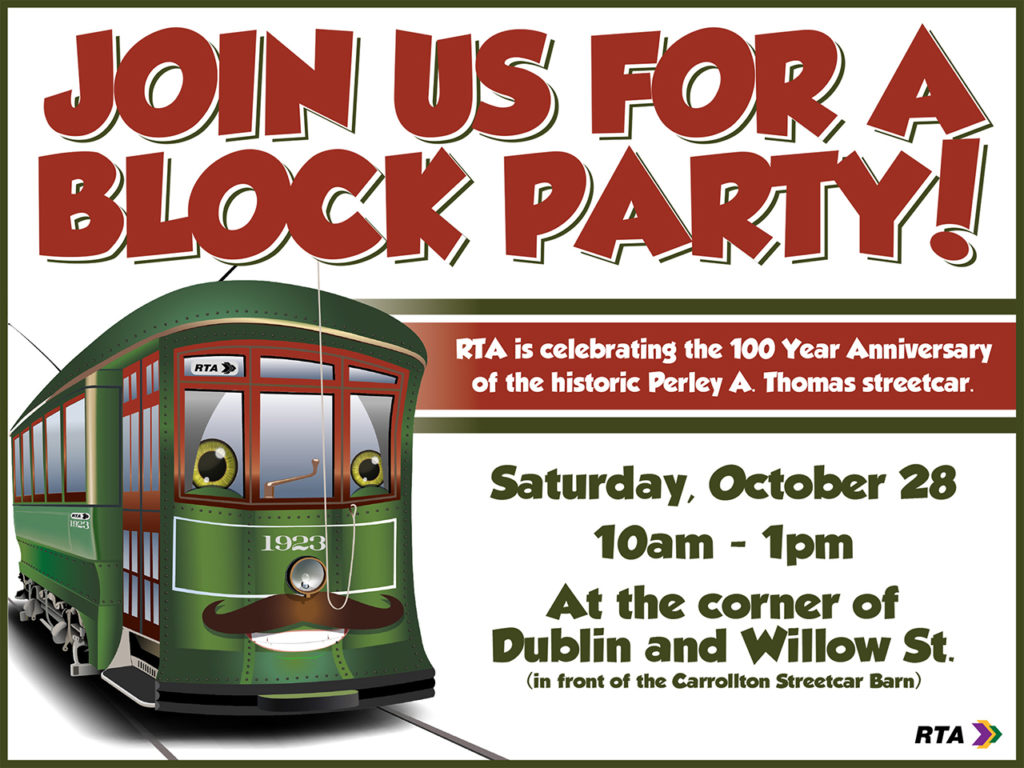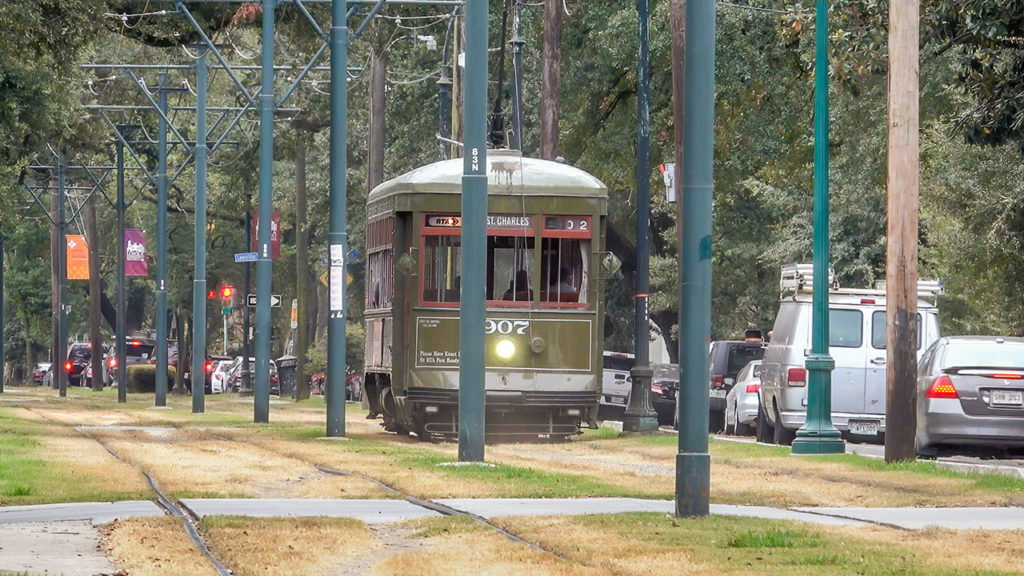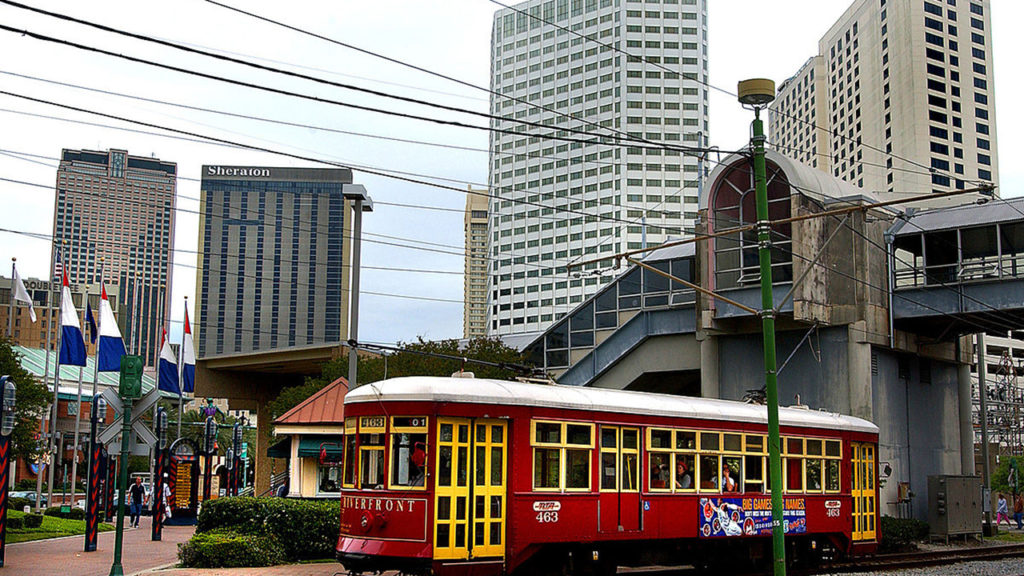
New Orleans Celebrates Streetcar Centennial
Written by David Peter Alan, Contributing Editor
Diego Delso/Wikimedia Commons
In an unusually low-key celebration for the Crescent City, the New Orleans Regional Transit Authority (RTA) held a block party and conducted tours of its historic Carrollton Barn in the Riverbend section of the city to celebrate the centennial of the streetcars that that have been running on St. Charles Avenue in regular service for all their 100 years. By transporting both New Orleanians and visitors for that length of time, the cars have become an integral part of the city’s culture and legend.
RTA publicized the event in its newsletter, Rider’s Digest, on its website, and through numerous other means. “We promoted the event heavily on our social media channels, through our outreach team at multiple neighborhood and community events, our intergovernmental relations team, and outreach to local media including our CEO Lona Edwards Hankins appearing on morning TV, and other direct media outreach including our advisory and calls,” according to David Lee Simmons, Director of Communications. “We were very excited and appreciative of the turnout, which at about 300 visitors was almost perfectly suited to the modest space that included the outer area of the Carrollton Streetcar Barn along with the city block we had cordoned off. We hope to make this a regular event.”

The website posting included a graphic that looked like a poster (above) and the description of the three-hour event: “Join RTA as we celebrate the 100-year anniversary of the historic Perley A. Thomas streetcar with a block party at our Carrollton Streetcar Barn. This family-friendly event will include snowballs, cotton candy, popcorn, refreshments, face painting and more! The celebration will run from 10 to 1 p.m., in between Dublin and Willow streets, and is free and open to the public.”
A “snowball” in New Orleans is a local style of shaved ice with flavored syrup poured on top, usually called a “snow cone” in other places. The cars themselves were built by the Perley A. Thomas Car Works in High Point, North Carolina, a company that makes school buses today.
The RTA website also summarizes the history of transit in New Orleans. Regarding the history of the St. Charles Avenue line where the historic cars have run throughout their history, the site says: “The oldest component of the RTA is the St. Charles streetcar line. It began in 1835 as a passenger railway between New Orleans and a suburb called Carrollton, which has since been absorbed into the city. The St. Charles line was one of the first passenger railroads in the country, and it remains the oldest continuously operating street railway in the world.”
While the latter claim is questionable, since the line was taken out of service and rebuilt after Hurricane Katrina devastated the city in 2005, there is no dispute concerning the venerable line and its impact on the history and culture of the Crescent City. A drawing of the sort-of horse-drawn car that ran during the early days of the line is located on the page, across from the quoted material. The line was electrified in 1893, and the cars now in use were ordered in 1920 and delivered in 1923 and 1924.

Around the time the cars entered service, the city consolidated streetcar operations and merged them with the gas and electric utilities into New Orleans Public Service, Inc. (NOPSI), a common model at the time. As also happened in many places, the transit component split off from the gas and electric utilities in 1979, when the Louisiana legislature established the Regional Transit Authority (RTA). The RTA assumed control over the city’s buses and the St. Charles streetcar line in 1983.
Through it all, the venerable cars continued to provide reliable service and an enjoyable ride to tourists and New Orleanians alike. In 1964, the slightly older 800-series streetcars were removed from Canal Street, the city’s main street and one of the world’s widest. There were four tracks on the street a century ago, but they were eventually torn up, except for a single block between Corondelet Street and St. Charles Avenue, where the St. Charles line turns around to go back uptown.
The line, with the historic cars numbered in the 900s, was listed on the National Register of Historic Places in 1973. In 2014, it was named a National Historic Landmark. An RTA press release from that time said: “The St. Charles Avenue Streetcar Line is also significant for its 35 arch-roofed, steel-bodied green Perley A. Thomas streetcars, which represented an evolution in the engineering of streetcar technology and have operated on the line’s tracks since 1923. National Historic Landmarks are historic places that possess exceptional value in commemorating or illustrating the history of the United States.” Only San Francisco’s cable cars, which are also unique, have been similarly honored.
Except for a few “modern” touches, like LED headlights for increased brightness to improve safety, the cars retain their historic paint scheme, wooden walkover seats, windows that can be opened, traction motors that grind, compressors that make their own unique sound, and other features that evoke the flavor and the congeniality of local transit from a bygone era. Nowhere else have members from a class of electric streetcars operated for so many years in everyday revenue service.
Streetcars have made a comeback in New Orleans more recently, starting with the Riverfront streetcar line between the Mississippi River and the French Quarter, which began running in 1988 on a track that had been used for freight traffic. The big event in the rebirth of the streetcar system came in 2004, when service returned to Canal Street, with its branches to City Park and to the city’s famous above-ground cemeteries, even though a short segment of that line had operated briefly before the full line came back.
Years later, a relatively short line on Loyola Avenue connected Canal Street to Union Passenger Terminal, where Amtrak trains and intercity buses stop. Until 2019, cars from there went through a half-grand-union onto another new line along Rampart Street (along the opposite edge of the French Quarter from the river) and St. Claude Avenue. A building collapse four years ago halted service there, and it has not returned, although the RTA says and area residents hope it will come back soon.
The celebration also included tours, some led by RTA CEO Lona Edwards Hankins. RTA reported on the event in a press release issued on Nov. 1, headlined RTA celebrates a century of the Perley A. Thomas streetcar with block party at Carrollton Streetcar Barn. The release quoted Hankins as saying: “It was an honor to join our community to celebrate the legacy of the Perley A. Thomas Streetcar, St. Charles Streetcar Line and the RTA workforce that has maintained the system for generations. We hope that by celebrating our skilled craftsman and their work to maintain our iconic streetcars, we are planting seeds in our young people who may one day want to pursue careers in transit, engineering and skilled trades. … These streetcars are revered for their artistry and meticulous construction. Of the 173 Perley A. Thomas streetcars originally ordered, 38 remain, with 10-13 in service on the St. Charles Streetcar line daily. The entire streetcar fleet is completely maintained by skilled RTA electricians, welders, carpenters, machinists and painters, often using antique tools and machines dating back to the 1900s. Originally purchased for $15,000 each, Perley A. Thomas replicas would cost nearly $4 million per car to build today.” In addition, the RTA mentioned that the agency is looking for employees with the skills to keep that tradition, as well as the cars themselves, going.
Local rider-advocate Alan S. Drake attended the event at the car barn, which proceeded without ceremony but delivered the promised snowballs and other refreshments, along with tours of the cars and the historic barn where they are kept and maintained when they are off duty. He enjoyed the low-key nature of the celebration, “devoid of speeches.” He also reported that many retirees and trusted employees showed up, and there was a great deal of reminiscing. “They could go wherever they wanted in the barn, and they showed the cars to visitors, probably unofficially” he said.
According to Drake, the century-old streetcars and historic buildings along the line complement each other well. He told me: “St. Charles Avenue is the most-picturesque street in the country, and having beautiful century-old streetcars elevates it to beat any competing boulevards.” It wasn’t only the buildings, he added: “The green streetcars go well with the live oaks and the neutral ground, too.” He mentioned a historic note: When NOPSI consolidated the electric, gas and streetcar utilities, management also wanted to unify the paint scheme on all cars. He said that, according to a local streetcar historian, the Army had surplus olive drab paint available for sale after World War I, so NOPSI used that color, and added: “That shade of green was designed to fit into the scenery, anyway.”
I first visited New Orleans and rode the historic cars in 1969, during my undergraduate days. Back then, an operator drove the car from the front, while a conductor stood on the rear platform and collected fares. It cost a dime to ride, and that fare was good for transfers on up to three buses to get riders to their final destinations for that base fare. When I visited the Carrollton Barn many years ago, Noah Flanagan, a manager who had started as a conductor, recalled how conductors were required to wear blue serge suits on duty and how uncomfortable they were during the city’s hot summers. Before service returned to Canal Street, I considered the single turnaround block for the St. Charles line to be particularly interesting, because it was the only block of that famous street where streetcars ran at all.
Today, the red cars with yellow doors designed by legendary streetcar engineer Elmer von Dullen run on Canal Street and other lines except St. Charles, which is reserved for the historic cars now entering their second century of service. They made a return appearance on Canal Street after Hurricane Katrina flooded the Mid-City car barn and the von Dullen cars inside. The Carrollton Barn sits on higher ground, so the historic cars ran on Canal Street while the “red cars” were being repaired. Drake recalled how some stops afforded only a narrow space for riders to board the cars or alight from them, because the cars only have right-side doors, and some stops on the line are designed for left-side doors. Still, apparently in true New Orleans style, the riders put up with the inconvenience that came with their ride.

Drake concluded our interview by saying: “New Orleans is a city of iconic images, like our statues, the Super Dome and unique local architecture, but in a city full of iconic images, our most-popular is a streetcar, either in Perley A. Thomas Green or von Dullen Red.” He mentioned that von Dullen worked at the agency for 49 years and that he and his crew “maintained the St. Charles cars for so long that they were able to build the von Dullen cars in-house, which nobody else in the world can do.”
On Aug, 10, 2020, Railway Age ran an essay I wrote, headlined Jazz and Rail: A 100-year Musical Landmark, which commemorated the 100th anniversary of the first blues record, Crazy Blues by Mamie Smith and her Jazz Hounds, and celebrated diversity both in jazz and on the rails. I contemplated my own interest in jazz (I played jazz piano in those days and sat in at a jazz club in New Orleans once) and how many of the musicians who gave jazz its start and those who still play the music in the city rode the legendary streetcars. I recalled how I had sat in during the Dixieland jam sessions in New York City more than 50 years ago, and one of the early “jazz greats” with whom I jammed was Tony Parenti, who had played clarinet with the New Orleans Rhythm Kings in 1924. He must have ridden the same now-honored cars when they were new that I have ridden many times, and that we can still enjoy today.
While advocates for increased bus service have criticized the streetcars, there seems little doubt that many New Orleanians treasure them both as an enjoyable way to get around, and also as an iconic symbol of their city. Tourists like to ride the historic cars on St. Charles Avenue, too. The city was down to a single streetcar line for decades, but it now has four, and advocates like Drake continue to call for expansion of the streetcar system and suggest a means for accomplishing it. Perhaps some of the impetus for local public opinion that calls for keeping the streetcars going, as well as for expanding the system, came from Tennessee Williams’s 1947 hit play A Streetcar Named Desire. The Desire Line was running at the time, and its route was near the route of the current, but now suspended, Streetcar Named Rampart – St. Claude. That means the old Desire route itself will probably never come back.
Still, in a twist of historic irony that could probably happen only in the Crescent City, Williams’s play might have strengthened A Desire Named Streetcar among his fellow New Orleanians, which continues to live today within their successors.

David Peter Alan is one of America’s most experienced transit users and advocates, having ridden every rail transit line in the U.S., and most Canadian systems. He has also ridden the entire Amtrak and VIA Rail network. His advocacy on the national scene focuses on the Rail Users’ Network (RUN), where he has been a Board member since 2005. Locally in New Jersey, he served as Chair of the Lackawanna Coalition for 21 years, and remains a member. He is also Chair of NJ Transit’s Senior Citizens and Disabled Residents Transportation Advisory Committee (SCDRTAC). When not writing or traveling, he practices law in the fields of Intellectual Property (Patents, Trademarks and Copyright) and business law. Opinions expressed here are his own.



